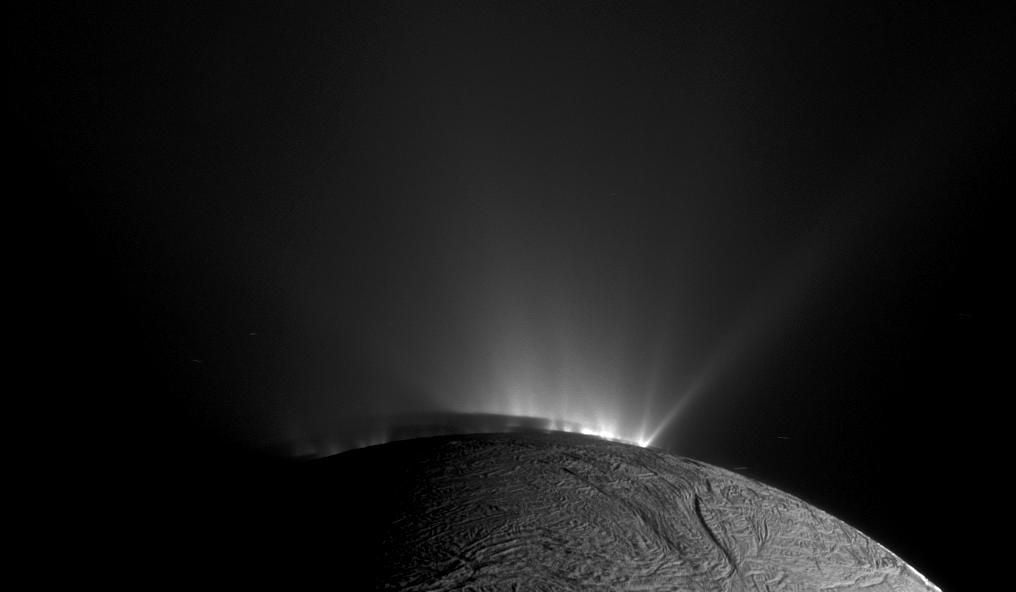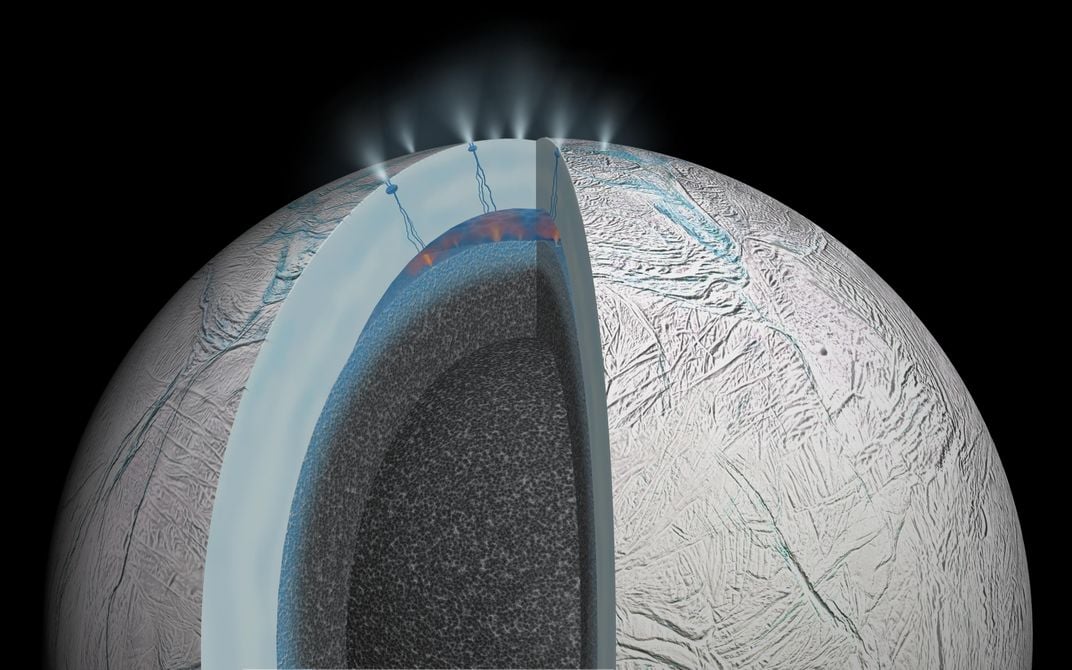NASA Spacecraft Heads for Deepest Ever Dive Into Saturn Moon’s Plumes
Cassini will plunge into the watery geysers to search for evidence of hydrothermal vents and other clues about the moon’s hidden ocean
/https://tf-cmsv2-smithsonianmag-media.s3.amazonaws.com/filer/28/0d/280d4a44-50f7-4713-87ea-edcfec850d55/enceladus-plumes.jpg)
Saturn's frozen moon Enceladus hosts a salty liquid ocean beneath its crust, and it's spraying samples out as if daring space travelers to taste its glacial goodness. On October 28, that's exactly what NASA's Cassini orbiter will do, making its deepest plunge ever into the liquid plumes spurting into space.
The dive through the plumes will offer a glimpse of the contents of that alien ocean—as well as clues to whether there are hydrothermal vents active on the icy moon's seafloor. Crucially, this week's close pass will be Cassini's next-to-last visit to Enceladus, so astronomers hope to get as much fresh data as possible about its watery interior.
"It's been years since we've had a close flyby of Enceladus, so we've had a lot of time to look at the data," says Cassini scientist Mark Perry of Johns Hopkins Applied Physics Laboratory in Maryland. "We have a lot of open questions, and now not many flybys left to try to answer them."
When the Cassini mission launched in 1997, scientists already knew there was something strange about Enceladus. The moon was brighter than expected when seen through a telescope, and images from the Voyager missions showed an unusual, wrinkly surface.
Then, in July 2005, Cassini's images revealed a huge cloud of water vapor over the moon's south pole, produced by bright plumes of water ice shooting from the surface. Further analysis revealed that the plumes are coming from beneath the crust.
"[Enceladus] was supposed to be frozen solid four billion years ago!" Perry says. "No way was it supposed to have any liquid in it, let alone squirting it out."
The source of the geysers remained a mystery for some time. At first, scientists thought the geysers might be drawing from a small, local subsurface pond. Only recently did gravity data from Cassini help astronomers determine that a liquid ocean lies beneath the surface of the entire moon.

Cassini's previous passes through the plumes showed that they contain salt and organic material—hinting that this ocean holds possible building blocks for life. And to the excitement of astrobiologists, recent analysis of dust around Saturn revealed that a stream of particles coming from Enceladus's plumes contains tiny silica-rich grains that likely formed around hydrothermal vents.
On Earth, hydrothermal vents in the deep ocean can support whole communities of life, and they may even be one of the places where living organisms first evolved on our planet. Confirming hydrothermal activity on Enceladus would be a strong sign that the small moon currently has environments suitable for life.
Perry works with the Ion and Neutral Mass Spectrometer (INMS), one of the two instruments that will take key measurements as Cassini passes through the plumes this week. The INMS will search for signs of hydrogen originating from deep beneath Enceladus' surface.
Previous passes through the plumes found hydrogen, but scientists haven't been able to determine yet if it exists on its own or if the detections result from the breakdown of water molecules. For this flyby, INMS will be in a special open configuration that will finally reveal if any of the hydrogen comes from interactions between the rock and the ocean layer at active vents.
"It's going to be a very nice, simple, direct test of this idea that there might be native hydrogen venting from Enceladus," says Bill McKinnon of Washington University in St. Louis, another member of Cassini's INMS team.

In addition, Cassini's Cosmic Dust Analyzer will look for organic particles during the upcoming dive. Previous samples of the plumes identified volatile gases and organics, but from a greater distance. This week's dive will pass within 30 miles of the south polar region, hopefully allowing the spacecraft to identify some of the bulkier particles that would quickly fall back towards the surface.
"Truly the highlight will be this deep sampling of the gas and icy particles," says Cassini project scientist Linda Spilker of NASA's Jet Propulsion Laboratory.
As it plunges toward the planet, the spacecraft will also image the source of the plumes, structures called tiger stripes that slash across the south pole of Enceladus. Scientists still aren't certain if the liquid is bursting from the surface in individual jets or as wide curtains of material, or as a mixture of the two. After passing through the plumes, the spacecraft will turn around and capture them lit up in the sunlight, potentially helping to solve this mystery.
Cassini won't have much longer to study Enceladus, as it will make its final voyage by the world in December. The spacecraft itself is in excellent shape but is almost out of fuel. Rather than losing control and having the craft crash into intriguing moons like Enceladus or hazy Titan, Cassini will make a daredevil plunge between Saturn's innermost rings in 2017, studying the planet's upper atmosphere before vanishing into its depths—an act Spilker calls "going out in a blaze of glory."
"We've learned so much with the Cassini mission that we've in a sense rewritten all the books on the icy moons," Spilker said.
The close of the mission means that it may be years to decades until we get our next close look at an icy moon. NASA and the European Space Agency are collaborating on the upcoming JUICE mission to study Jupiter and three of its moons, but that's not slated to launch until 2022. And a NASA mission dedicated to Jupiter's moon Europa, another icy world with a subsurface ocean and possible plumes, is in the works but also would not launch until the 2020s.
Still, Perry notes that everything learned at Enceladus should be further enhanced at Europa, now that we have a better idea of what to look for. And many scientists are expressing hope for a future mission to revisit Enceladus, this time with instruments designed especially for its plume. Such a mission could make multiple flybys, orbit the moon or even land on it, building on the wealth of data returned from Cassini's flybys.
"It's been a magnificent success," says Francis Nimmo at the University of California, Santa Cruz. "Who would have guessed that Enceladus was going to be as interesting as it turned out to be."
/https://tf-cmsv2-smithsonianmag-media.s3.amazonaws.com/accounts/headshot/NTR_headshot.jpg)
/https://tf-cmsv2-smithsonianmag-media.s3.amazonaws.com/accounts/headshot/NTR_headshot.jpg)